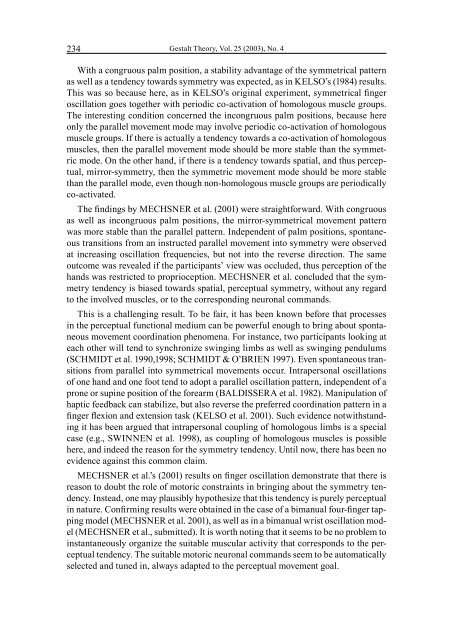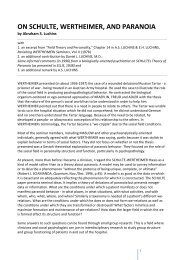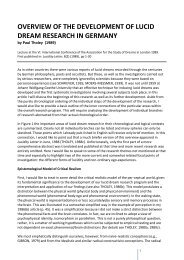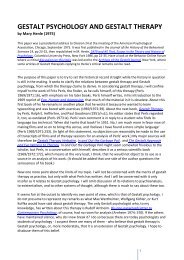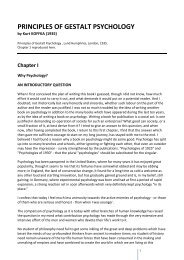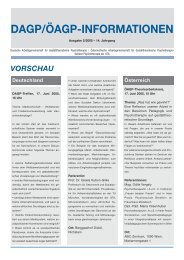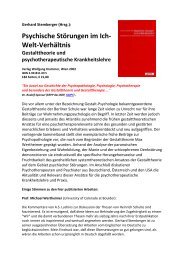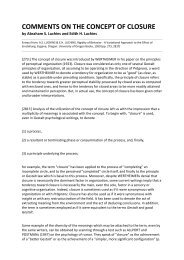Gestalt Factors in Human Movement Coordination - Society for ...
Gestalt Factors in Human Movement Coordination - Society for ...
Gestalt Factors in Human Movement Coordination - Society for ...
You also want an ePaper? Increase the reach of your titles
YUMPU automatically turns print PDFs into web optimized ePapers that Google loves.
234<strong>Gestalt</strong> Theory, Vol. 25 (2003), No. 4With a congruous palm position, a stability advantage of the symmetrical patternas well as a tendency towards symmetry was expected, as <strong>in</strong> KELSO’s (1984) results.This was so because here, as <strong>in</strong> KELSO’s orig<strong>in</strong>al experiment, symmetrical f<strong>in</strong>geroscillation goes together with periodic co-activation of homologous muscle groups.The <strong>in</strong>terest<strong>in</strong>g condition concerned the <strong>in</strong>congruous palm positions, because hereonly the parallel movement mode may <strong>in</strong>volve periodic co-activation of homologousmuscle groups. If there is actually a tendency towards a co-activation of homologousmuscles, then the parallel movement mode should be more stable than the symmetricmode. On the other hand, if there is a tendency towards spatial, and thus perceptual,mirror-symmetry, then the symmetric movement mode should be more stablethan the parallel mode, even though non-homologous muscle groups are periodicallyco-activated.The f<strong>in</strong>d<strong>in</strong>gs by MECHSNER et al. (2001) were straight<strong>for</strong>ward. With congruousas well as <strong>in</strong>congruous palm positions, the mirror-symmetrical movement patternwas more stable than the parallel pattern. Independent of palm positions, spontaneoustransitions from an <strong>in</strong>structed parallel movement <strong>in</strong>to symmetry were observedat <strong>in</strong>creas<strong>in</strong>g oscillation frequencies, but not <strong>in</strong>to the reverse direction. The sameoutcome was revealed if the participants’ view was occluded, thus perception of thehands was restricted to proprioception. MECHSNER et al. concluded that the symmetrytendency is biased towards spatial, perceptual symmetry, without any regardto the <strong>in</strong>volved muscles, or to the correspond<strong>in</strong>g neuronal commands.This is a challeng<strong>in</strong>g result. To be fair, it has been known be<strong>for</strong>e that processes<strong>in</strong> the perceptual functional medium can be powerful enough to br<strong>in</strong>g about spontaneousmovement coord<strong>in</strong>ation phenomena. For <strong>in</strong>stance, two participants look<strong>in</strong>g ateach other will tend to synchronize sw<strong>in</strong>g<strong>in</strong>g limbs as well as sw<strong>in</strong>g<strong>in</strong>g pendulums(SCHMIDT et al. 1990,1998; SCHMIDT & O’BRIEN 1997). Even spontaneous transitionsfrom parallel <strong>in</strong>to symmetrical movements occur. Intrapersonal oscillationsof one hand and one foot tend to adopt a parallel oscillation pattern, <strong>in</strong>dependent of aprone or sup<strong>in</strong>e position of the <strong>for</strong>earm (BALDISSERA et al. 1982). Manipulation ofhaptic feedback can stabilize, but also reverse the preferred coord<strong>in</strong>ation pattern <strong>in</strong> af<strong>in</strong>ger flexion and extension task (KELSO et al. 2001). Such evidence notwithstand<strong>in</strong>git has been argued that <strong>in</strong>trapersonal coupl<strong>in</strong>g of homologous limbs is a specialcase (e.g., SWINNEN et al. 1998), as coupl<strong>in</strong>g of homologous muscles is possiblehere, and <strong>in</strong>deed the reason <strong>for</strong> the symmetry tendency. Until now, there has been noevidence aga<strong>in</strong>st this common claim.MECHSNER et al.’s (2001) results on f<strong>in</strong>ger oscillation demonstrate that there isreason to doubt the role of motoric constra<strong>in</strong>ts <strong>in</strong> br<strong>in</strong>g<strong>in</strong>g about the symmetry tendency.Instead, one may plausibly hypothesize that this tendency is purely perceptual<strong>in</strong> nature. Confirm<strong>in</strong>g results were obta<strong>in</strong>ed <strong>in</strong> the case of a bimanual four-f<strong>in</strong>ger tapp<strong>in</strong>gmodel (MECHSNER et al. 2001), as well as <strong>in</strong> a bimanual wrist oscillation model(MECHSNER et al., submitted). It is worth not<strong>in</strong>g that it seems to be no problem to<strong>in</strong>stantaneously organize the suitable muscular activity that corresponds to the perceptualtendency. The suitable motoric neuronal commands seem to be automaticallyselected and tuned <strong>in</strong>, always adapted to the perceptual movement goal.


